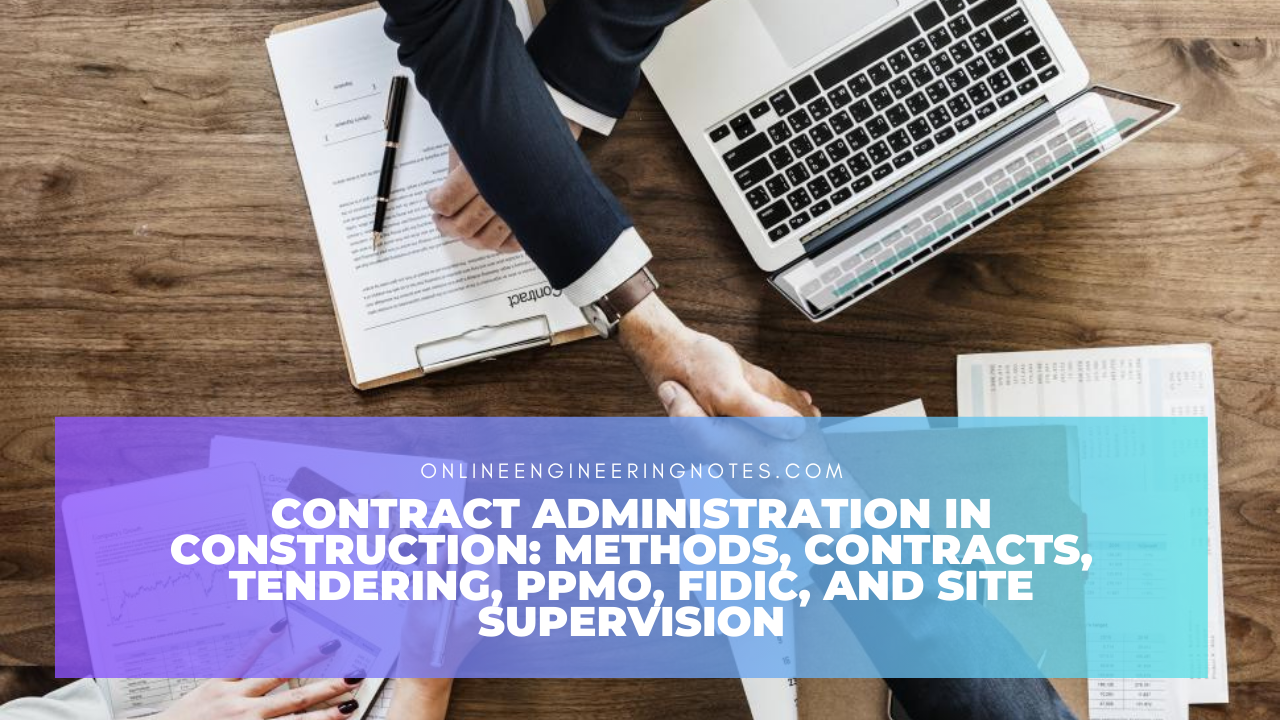1.1 Method of work execution
- Refers to approach or strategy used to carry out tasks and activities in project.
- Method of work execution depends on project nature, resource and objective.
| S/N | Procurement Method | Contract Size | Contractor |
| 1 | Sealed Bidding | ||
| a | ICB | Greater than 5 Billion NPR | International or Nepali |
| b | NCB/LCB | More than 20 Lakh to 5 Arab | Nepali |
| 2 | Sealed Quotation | Upto 20 Lakh | All |
| 3 | Direct Procurement | Upto 5 to 10 Lakh | All |
| 4 | Force Account | Upto 1 Lakh | None |
| 5 | Procurement Under Special Circumstance | Emergency/ Special Circumstances | Depends on Contract amount |
| 6 | Beneficiaries Community | Upto 5 Crore | Completion is made |
1. Sealed Bidding:
a. International competitive bidding (ICB): Global suppliers compete
b. National/Local competitive bidding (NCB/LCB): Local supplies compete.
2. Sealed Quotation: Supplies provide price for project goods or service.
3. Direct Procurement: Purchasing from a single supplier without competition.
4. Procurement under special circumstances: Non-competitive method for emergencies.
5. Force Account: Project owner’s team perform tasks.
6. Beneficiaries community: Local community involvement in project execution.
1.2 Contract-definition
- Contract is a formal agreement between parties that outlines obligation and rights.
Importance:
- Establish a shared understanding of what is expected from each party.
- Protect interest and right of all parties involved.
- Ensure financial security and business confidence.
- Minimize dispute.
- Provide legal protection.
1.3 Types of construction contract
1. Unit price contract:
- Contractor is paid based on quantities of work at predetermined unit price.
Advantages:
- Flexible for varying work amount.
- Easy to measure work progress.
Disadvantages:
- Final Cost uncertainties.
- Potential for disputes over quantities.
2. Lump sum contract:
- Contractor agrees to a fixed sum for completing the entire project.
Advantages:
- Clear cost and scope.
- Low owner risk.
Disadvantages:
- Limited flexibility for changes.
- Potential dispute over scope changes.
3. Cost plus contract:
- Contractor is paid for actual cost plus a free.
Advantages:
- Transparency in costs.
- Flexible for changes.
Disadvantages:
- Uncertain in final cost.
- Potential for higher expenses.
4. Design and Build Contract:
- Contractor handles both design and construction responsibilities.
Advantages:
- Faster delivery.
- Streamlined process.
Disadvantages:
- Limited owner design control.
- Potential conflict.
5. EPC (Engineering, Procurement and Construction) contract:
- Contractor handles engineering, procurement and construction.
Advantages:
- Single responsibility.
- Suitable for complex projects.
Disadvantage:
- Higher cost.
- Potential for dispute.
6. BOOT (Build Own Operate Transfer) contract:
- Contractor builds, operate and transfer ownership after a specified period.
Advantages:
- Private financing and operation.
- Risk transferred to contractor.
Disadvantages:
- Limited control for owner.
- Higher cost to end user.
1.4 Tender and tender documents
Tender:
- It is an offer or proposal submitted by a contractor or supplier in response to an invitation to bid for a project.
- Contractor or suppliers compete by providing their best price and terms to win the project contract.
Tender document: (Bidding document)
- It is the detailed instruction and information provided to potential contractors for submitting tenders.
- It includes:
- Notice of invitation for bids
- Letter for invitation for bids
- Project description
- Instruction to bidders
- Bid submission requirement
- Technical specification
- Contract terms
1.5 Tender notice
- Public announcement issued by an organization or government agency to invite potential contractor suppliers to submit their bids or proposal for a specific project or service.
- Information in Tender notice:
- Date, time and place of tender
- Name of authorities inviting tender
- Nature of work and its location
- Tender deadline
- Eligibility criteria
- Contact details
- Bid submission information
1.6 Preparation before inviting tender
- Project preparation: Define project need and requirement.
- Estimating quantities: Calculate required materials and resource.
- Cost estimate: Determine the projects overall cost.
- Approval of estimate: Get approval for the cost calculation.
- Resource planning: Plan and allocate necessary resource.
- Tender document preparation: Create detailed tender document with project information.
1.7 Consultant’s/Contractor’s prequalification
- Prequalification is a selection process where potential consultants or contractor are evaluated based on their qualification, experience and financial capacity before being invited to bid for a project.
Matters to be stated in prequalification documents:
- Company information: Name, address, contact and legal status of the consultant/contractor.
- Experience and track record: Details of past project and relevant work completed.
- Financial statement: Proof of financial stability and capacity to handle the project.
- Technical capacities: Description of expertise and available resource.
- Reference: Client feedback to verify past performance and reputation.
Advantages:
- Ensures qualified and experienced candidate.
- Saves time in evaluating irrelevant proposals.
Disadvantages:
- Reduce competition.
- Increases administrative workload.
1.8 Bid evaluation and selection of a consultant and contractor
Bid Evaluation:
- Process of selecting most suitable and qualified bidder for project based on predefined evaluation criteria.
Steps of Bid Evaluation:
- Opening of Bid: Publicly reveal and record submitted bids.
- Preliminary Examination: Review bids for clear information and meeting basic requirement.
- Prequalification Check: Verify bidder’s qualification and eligibility.
- Detail Evaluation: Evaluate technical and financial aspect of bids using predefined criteria.
1.9 Contract agreement
A written document that explains the terms and condition of an agreement between parties.
2.0 Condition of contract (PPMO and FIDIC)
- The terms and provision that governs the right, obligations and responsibilities of parties in a contractual agreement is called condition of contract.
PPMO (Public Procurement Management Office):
- PPMO is the governing body in Nepal responsible for managing public procurement and setting the contract for government project.
- Aims for transparency, efficiency and fairness in government projects.
FIDIC (International Federation of Consulting Engineers):
- FIDIC is an international organization that sets standard condition of contract for construction and engineering projects worldwide.
- Focuses on fair risk allocation and transparency.
2.1 Public Procurement Act and Public Procurement Regulation
Public Procurement Act (PPA):
- It is a legal framework that governs the procurement process for public projects and services.
Objective:
- To ensure transparency, fairness in public procurement.
- To promote completion among bidders.
Feature:
- Provide rules and guideline for public procurement.
- Defines procurement method.
Public Procurement Regulation (PPR):
- It provides detailed guideline and procedure to implement the public procurement act.
Objective:
- To standardized application of procurement practice.
Feature:
- Specifies procurement procedure.
- Bid evaluation.
- Contract management.
2.2 Duties and responsibilities of a site supervisor
Site Engineer:
- A professional engineer responsible for managing and supervising construction activities on site.
- Ensures that the project is executed accordingly to design, quality standard and safety regulation.
Responsibilities of a site supervisor:
1. Quality concerns
- Ensure construction work meets specified quality standards.
- Conduct inspection and check quality and fix any issues.
- Maintain accurate records of quality control measures and improvement.
2. Progress concerns
- Monitor and track daily progress of construction activities on site.
- Report progress to project manager.
3. Cost concerns
- Manage and optimize the use of materials and resource to control costs.
- Keep track of expenses and budget to avoid over spending.
2.3 Supervising work of a contractor
Works followed for supervision of works of a contractor:
1. Progress of work:
- Regular monitoring and supervision.
- Checking schedule periodically.
2. Testing:
- Works, material & equipment.
- Testing as per specification and contract.
3. Regular supervision of works:
- Field supervision.
- Environmental protection, safety of workers.
2.4 Site order book
- A record-keeping book used on construction sites to document various instruction, orders and changes issued by the site supervisor or engineer.
- Helps communicate and track on site decisions to contractor and workers.
2.5 Procedure to prepare bill
- Bills are the claims for payment of work performed.
Steps to make bill for payment in construction project management:
- Keep a record of completed work and resource used.
- Measure the quantities of material and labor.
- Find the cost for each unit of resource used (Rate analysis).
- Calculate individual costs by multiplying quantities with rates.
- Add up all costs for different components (add subtotal).
- Includes additional expenses like taxes or overhead.
- Apply any applicable discounts or taxes.
- Show final bill to client for payment.
2.6 Difference between Running Bill and Final Bill
| Running Bill | Final Bill |
| Submitted periodically during the project. | Submitted at project completion. |
| Covers work done upto a certain date. | Covers the entire project. |
| Helps track payment and cost. | Provide final financial settlement for project. |
2.7 Muster roll, Measurement books
Muster Roll:
- Used for keeping a complete record of attendance, payment made, unpaid wages and work done by daily labor.
- It has three parts:
Part I: Detailed information of labor engaged, attendance, rate
Part II: Record of unpaid wages.
Part III: Record of completed works.
Measurement Books:
- Used on construction sites to document the measurement of completed work and resource used.
- Feature:
- Contains details of work and date.
- All measurement is recorded in ink.
- Quantity of work done is recorded.
2.8 Progress reporting
- Regular updates on the status of project tasks.
- Includes completed tasks, milestone reached and challenged encountered.
- Gives information for making adjustment and strategic decision.
Reference:
• Harold Kerzner (2017). Project Management: A Systems Approach to Planning, Scheduling, and Controlling.
• PMI (2021). A Guide to the Project Management Body of Knowledge (PMBOK® Guide) – 7th Edition.
• Nebosh, Nepal Engineering Council Syllabus (2024). Engineering Professional Practice Notes.
• Civil Engineering Standard Method of Measurement (CESMM).
• Personal Class Notes & Presentations from Nepalese Engineering Institutions.

